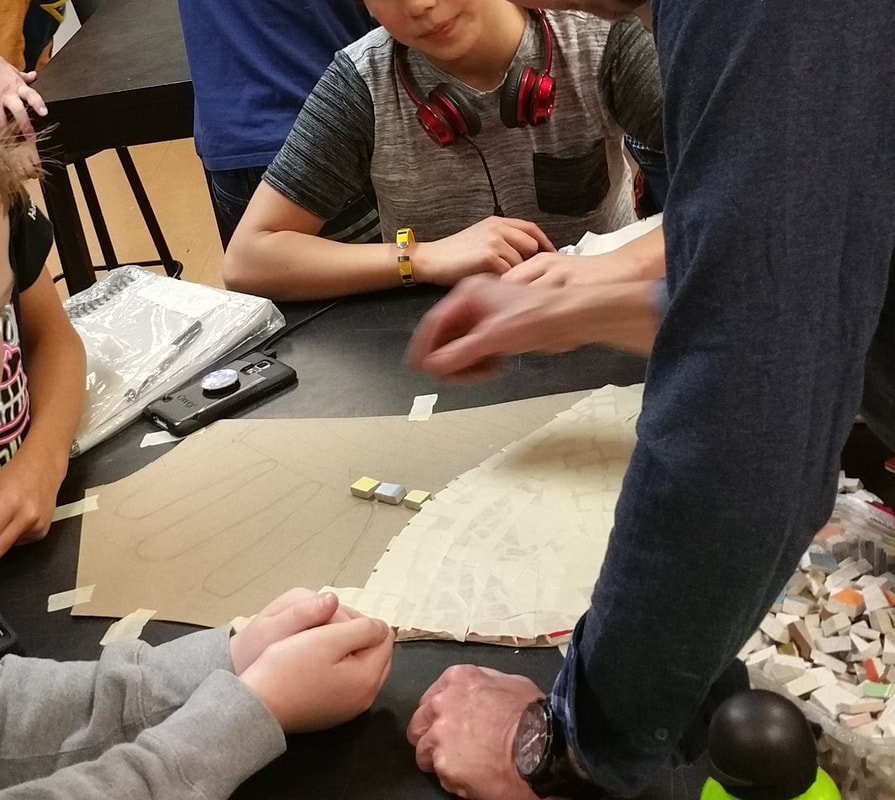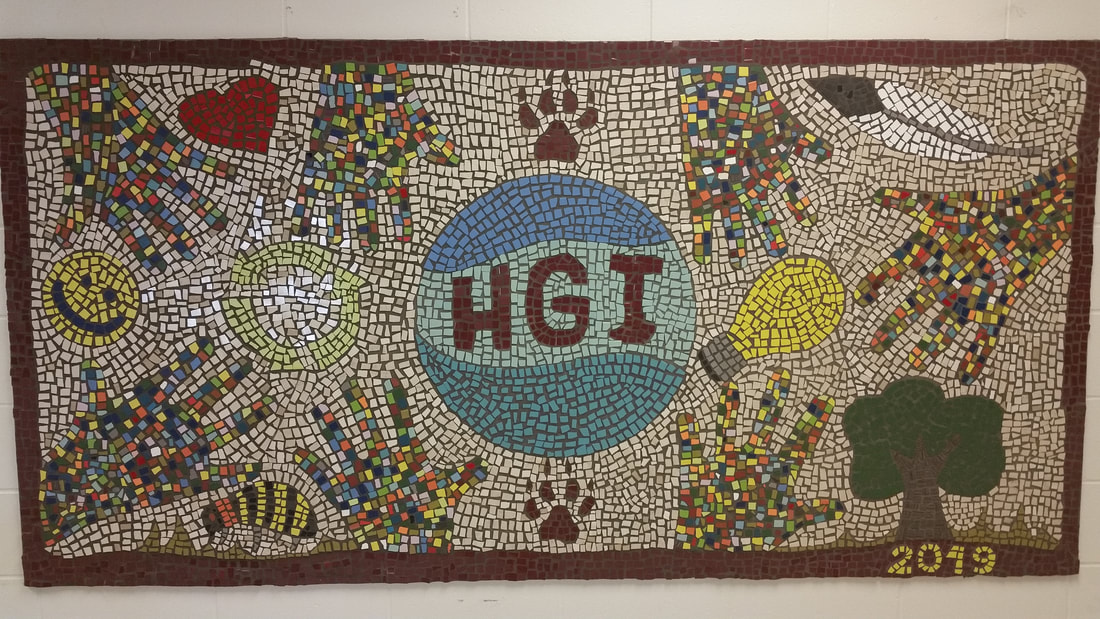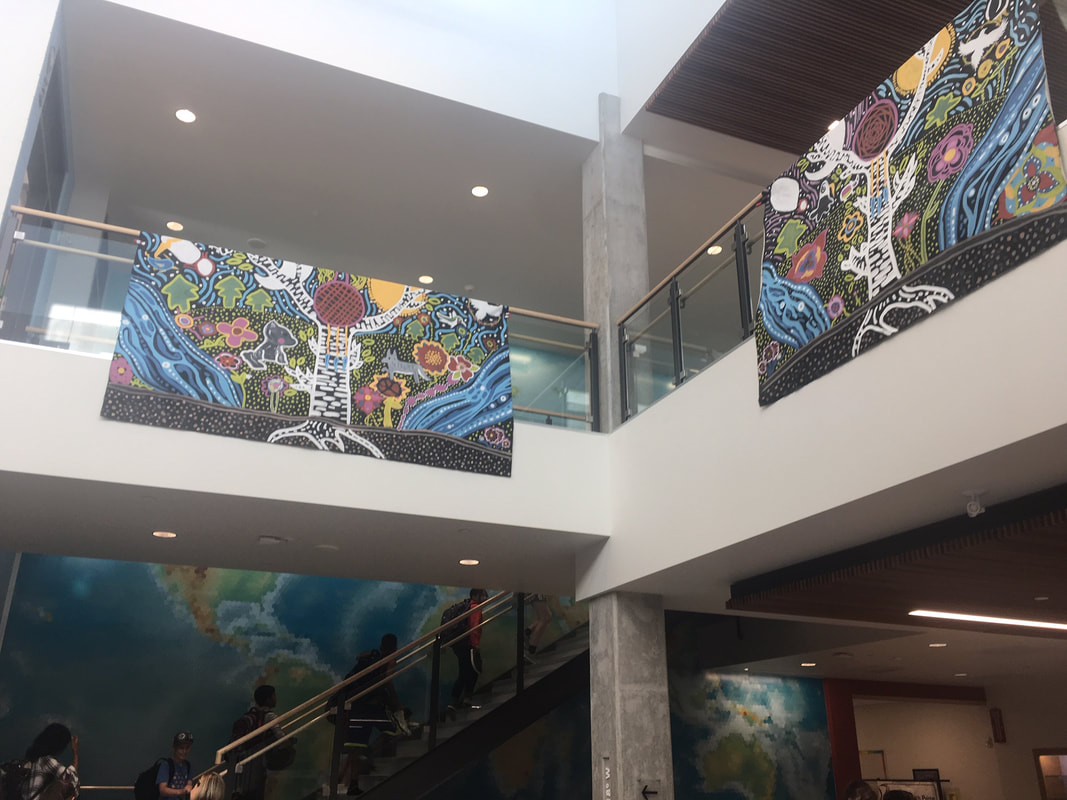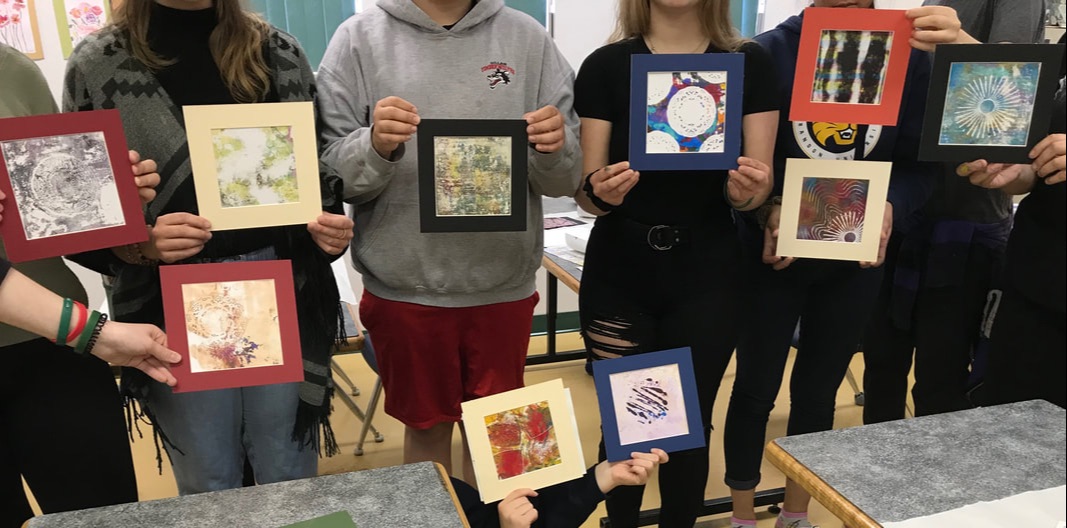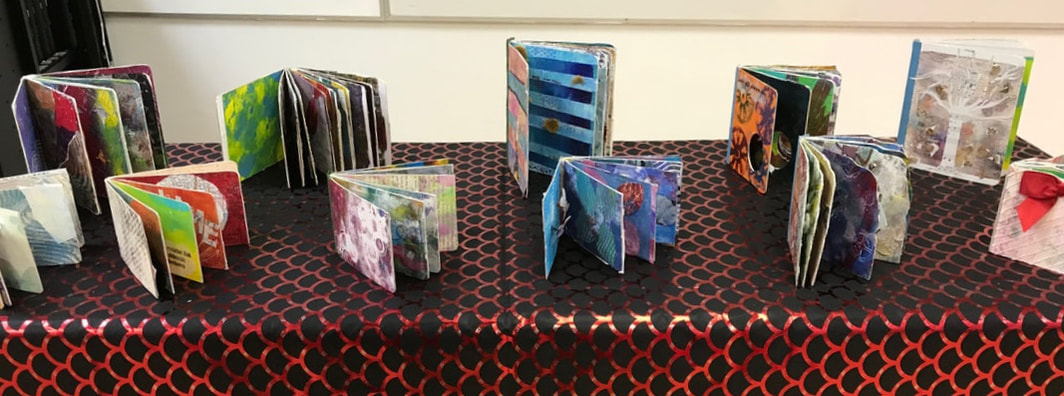MoSAIC MURAL - $1,000 GRANT
HEnry G. IZATT MIDDLE SCHOOL
by melanie thwaites, art specialist
|
On January 7, 2019, one hundred fifty seven grade 6 students attending Henry G. Izatt Middle School began a three week mosaic building process, led by local artist-in-the-school, Dimitry Melman. The end product – a visually stunning, permanent mosaic mural installation. An installation for students, staff, and community alike to view, enjoy, and feel proud of. A mosaic mural to represent their legacy, their school, and the four main pillars that are imbedded into everyday learning: 1) Humanity, 2) Growth, 3) Innovation, and 4) Sustainability (i.e., the HGI’S).
Week 1: During the first week of the artist residency, students had the opportunity to get to know Dimitry and the type of work that he does. He introduced the students to the art of mosaics, and presented images of his pieces that can be found throughout the city. The students were very excited to see his work, and ask him questions about his process. As well, during this first week Dimitry discussed HGI’s pillar concepts with the students. He then took them through the process of sketching their ideas out onto paper. Dimitry collected their sketches as they were completed. He then compiled their ideas into a large collage – a scaled outline of the mural on brown paper. As the week progressed, Dimitry began working with small groups of students. He provided one-on-one guidance for each student in class, so they could have hands-on experience with the large tile cutter and small hand clippers. The students understood that these small pieces were going to be included into the permanent mosaic installation. It was very evident that this was a highlight for the students. They were very proud and engaged in their learning, as some had never used tile cutters or small hand tools before! At the end of the week, Dimitry designated some practice time to organizing tiny mosaic pieces of the same colour onto brown paper. Working in small groups, the goal was to line up similar colours in a creative fashion, leaving just the right amount of space between each piece. The students had to learn to be mindful of borders and to collaborate. It was a lot of hard work! To end the first week, Dimitry got the students to lay masking tape onto the small groupings of tiles, to preserve their work for the week ahead. Week 2: The second week of the residency was dedicated to the snipping and organizing of hundreds of tiny ceramic tile pieces. Dimitry had previously separated the scaled mural outline into smaller workable sections. Each day, homeroom classes would visit the art room. Students in each homeroom would separate into small groups and work together to complete a section. Homeroom classes would rotate through the art room, taking over each section where the last group left off. From a student’s perspective, this was a really important experience. Individuals would have to “let go” of their work, and trust that the next group would continue to work with just as much care and creativity. Week 3: The third week marked the closing of our project. Students in each homeroom class created a small mosaic piece to take back to their teachers. Classes of students gathered in the front foyer of our school to watch Dimitry apply adhesive to the wall. Then Dimitry showed everyone how to apply the grout to the tiles. Pictures and video footage were taken to record the installation of the mural. Those passing through the hallway stopped to watch, ask questions, and admire the process. In closing, it was an AWESOME project that touched so many people! |
SUNDANCE BANNERS with PAHAN PTESAN WIN - $1,000 GRANT
ECOLE SOUTH POINTE and HENRY G IZATT MIDDLE SCHOOL
REPORT by ALLISON MOORE
With the passing of the cold dark winter and the arrival of spring many Indigenous peoples begin to prepare for the sacred ceremony of the Sundance. Sundances happen all across North America over the summer months.
|
I have been very lucky to volunteer with a local Sundance run by Pahan Pte San Win. Her name means Grey Swan Buffalo Woman. It is very rare for women to run a Sundance. This June students at École South Pointe and Henry G Izatt Middle Schools were honored to have Pahan come to speak with a select group of students, a grade 5 class from South Pointe as well as the Indigenous Student Group at H.G. Izatt.
Before Pahan arrives we sit in a circle. She is a small woman with a warm smile, long greying hair and wears a traditional ribbon skirt. Once seated, she is offered tobacco for sharing her teachings with us. When Pahan introduces herself, tells us the meaning of her name, where she is from and tells the children to call her kooshi which means grandmother in her Lakotah language. Pahan is Lakotah, Cree and Metis. |
|
When she talks to the students she begins by asking them what they know of the word Indigenous. What does it mean? She tells us that people, plants, and animals can claim indigeneity to place. She asks the groups if they know the names of the peoples who are Indigenous to the lands we live on. Many students are able to answer; First Nations, Inuit, and Metis. Within those groups we identify Ojibwe, Cree, Dene and Lakotah peoples here in Treaty One territory.
Pahan moves on to tell us about a vision she had as a young person. When her mother was pregnant with her a woman gave her mother a painting of a man which she in turn hung up in Paha’s room. Early one morning as a young child she woke to hear the man in the painting speaking to her. This was the first vision she recalls but it was not the last. The ideal of taking the lead in the Sundance also came through a series of visions. t the Sundance we learn that there is a beautiful tree that the women dance around. This particular Sundance is help to honour the many missing and murdered Indigenous women. It is a place for their families to find their spirits and a sense of peace. When she is finished telling her story she shows us a selection of beautiful banners that have already been created. They are very diverse, some are painted, other are sewed with fabric and another has a collaged element to it. |
After hearing Pahan’s story and looking at the banners together the students went to work developing drawings to adorn the banners that, in August, will be used to create a kind of gallery wall around the arbor where the dancers rest in between the four days of dancing.
The students at South Pointe were also inspired by the large scale paintings of Christi Belcourt, a Métis artist who incorporates animals and plants in semi-symmetrical compositions that appear to mimic Métis beadwork. The children worked on individual drawings of the land, the sky, animals and plants. After completing their designs they were able to work in small groups adding their own imagery to the collaborative work. We were also able to complete a second banner that will reside in our school, reminding us of our relationship with the world around us, the Sundance and those who are no longer here.
HG Izatt took a different approach to their banner, creating a landscape with a human presence. After Pahan’s presentation with these students she stayed and drew with us. She also showed us her beaded necklace with a large image of a Sundancer. Although we drew trees and rivers, hills and skies onto the banner we also included teepees and most importantly the Sundancers who were created in the image of Pahan’s necklace. One of the girls in the group drew a significant portion of the banner in a fluid inspired kind of way and finished up with a flourish of spirit lines coming from the dancers.
The students were very proud and happy with their work. I overheard a girl announce “I can’t believe I am making something for someone else! I’m so excited about this!” Many students talked about how much they love art as they worked. One girl shared that all she wants to do is make art and be an artist. Another connection I found interesting was when I heard the children talking and connecting what they had heard from Pahan with their own beliefs and religious practices. I look forward to sharing these beautiful works with the Pahan and the Sundance knowing that our students have been able to contribute to something exceptional and important in our larger community.
The students at South Pointe were also inspired by the large scale paintings of Christi Belcourt, a Métis artist who incorporates animals and plants in semi-symmetrical compositions that appear to mimic Métis beadwork. The children worked on individual drawings of the land, the sky, animals and plants. After completing their designs they were able to work in small groups adding their own imagery to the collaborative work. We were also able to complete a second banner that will reside in our school, reminding us of our relationship with the world around us, the Sundance and those who are no longer here.
HG Izatt took a different approach to their banner, creating a landscape with a human presence. After Pahan’s presentation with these students she stayed and drew with us. She also showed us her beaded necklace with a large image of a Sundancer. Although we drew trees and rivers, hills and skies onto the banner we also included teepees and most importantly the Sundancers who were created in the image of Pahan’s necklace. One of the girls in the group drew a significant portion of the banner in a fluid inspired kind of way and finished up with a flourish of spirit lines coming from the dancers.
The students were very proud and happy with their work. I overheard a girl announce “I can’t believe I am making something for someone else! I’m so excited about this!” Many students talked about how much they love art as they worked. One girl shared that all she wants to do is make art and be an artist. Another connection I found interesting was when I heard the children talking and connecting what they had heard from Pahan with their own beliefs and religious practices. I look forward to sharing these beautiful works with the Pahan and the Sundance knowing that our students have been able to contribute to something exceptional and important in our larger community.
GEL PLATE PRINTS
Prairie mountain high school
report by wendy wear
|
Prairie Mountain High School was successful in receiving an MAAE grant to bring an artist into the school in the Spring of 2019. As such, Heather Martens Rempel travelled to Somerset, MB and gave us a two day workshop in the mornings of April 25 and April 26, 2019. I cannot emphasize strongly enough how this art workshop could/would not have taken place without the grant monies received from MAAE. We are a small rural high school with a limited budget for arts and that is just an educational reality in a small community. Heather began the workshop by introducing herself and having the students (10/11) introduce themselves to her. She then reviewed the history of gel plate printing and touched on some of her experiences with this art form. Next, she introduced the tools of gel plate printing and how to use them (gel plate, acrylic paints, palette, brayer, papers, etc.) As she talked, she also introduced the specific terminology inherent in this art form, like the ‘ghost print’. After the students had an initial exposure to creating prints, Heather demonstrated using textured mediums to create depth and interest in their prints. The students then experimented with these materials. (string, sponges, combs, doilies, etc.) Heather also demonstrated how to use ‘found objects’ to create shape and form. From a pragmatic viewpoint, I learned what kind of paper to use (Mohawk, old Mayfair); using Amsterdam’s ‘Titanium Buff’ to lift the leftover paint off the gel plate; using Microsoft Word to print backwards; and using ‘projector plastic’ to create original stencils and the resulting ‘collograph print’. From a more esthetic viewpoint, I (as well as the students), were exposed to the positive and negative shapes and space inherent in this art form and the fact that sometimes the resulting gel plate print may not have been what was ‘expected or planned’. The final aspect of the workshop was to develop a project, an art object, created specifically from the prints created using the gel plates. Heather brought some hard board books (baby books) that the students could use to create a personal memoir of their prints. She also suggested that they might want to create a mobile or a collage or postcard from their art prints. For myself, I asked them to somehow incorporate their specific culture or social group as an aspect of their gel print project. Most of them chose to do a book project. To ensure that their backward words were ready to use, they were introduced to using gel medium as an adhesive to attach words to a specific gel print. Then the first step was to sand the covers of the book pages to make them a rough surface to attach their prints. Heather then demonstrated how to affix the prints to their book pages; using scissors or a knife and cutting board to create a 3-dimensional figure to attach to a page; and how to create a ‘pairing shape’ by ripping a print to create a different effect. Following the workshop, the students spent about a week finishing their book project and then on May 14, 2019, they showcased their books in an art exhibition for the community as part of the Prairie Mountain High School Spring Art Show. As the public viewed their pieces, I and some of the art students were able to explain the art of gel plate printing and the process involved in this art form. In conclusion, Heather Martens-Rempel was a talented ambassador for the art community and I would not hesitate to recommend her to anyone wishing a workshop on gel plate printing. |
MOCCASIN MAKING
Ecole laura secord school
report by Stephanie Gagnon, Grade 5 teacher
|
An overview:
During our cross-cultural beading activities, 48 students in grade five from École Laura Secord School worked with Gloria Beckman, a Residential School Survivor, to learn how to bead and sew a pair of moccasins. Gloria drew on traditional knowledge and techniques passed down to her by her family to lead this multistep and engaging project. In addition to Gloria’s exercises around traditional sewing and beading, she also shares her experiences as a Residential School Survivor. These lessons were especially significant for our classroom following the release of the Truth and Reconciliation Commission’s 94 Calls to Action due to the high percentage of calls for the resurgence of Indigenous educational methodologies and the inclusion of residential school history in the classroom from the perspective of Survivors. Our end goal was to develop a sense of confidence and the skills required to bead and sew while learning about our Canadian and indigenous history. |
Step-by-step moccasin making:
To begin, students needed to learn the basics; how to use a needle, tie a knot, work through trouble shooting, and learn about all the materials needed to make moccasins. Our students came with a wide range of knowledge when it came to sewing, and experienced individuals were there to help those who had never threaded a needle before. We were also happy to have many family volunteers from our community. Students began their project by sewing together the felt for the inside of their moccasins. This was a great way to get the students comfortable with sewing using the thin material first before working with leather.
Gloria returned to our classroom for the next step, to bead the star onto the top of their moccasins. Each student created two stars but chose the colour of beads that made sense to them. Some students decided to go with more traditional colours to represent the medicine wheel while others decided their moccasins would be a gift once completed, so they picked colours that would appeal to that person. Each star was personal and meant something to them. This step was strenuous, working with small beads and problem solving when faced with knots and multiple steps. The stars took approximately 5 hours before they were finally stitched onto the top of their half-completed moccasins.
To begin, students needed to learn the basics; how to use a needle, tie a knot, work through trouble shooting, and learn about all the materials needed to make moccasins. Our students came with a wide range of knowledge when it came to sewing, and experienced individuals were there to help those who had never threaded a needle before. We were also happy to have many family volunteers from our community. Students began their project by sewing together the felt for the inside of their moccasins. This was a great way to get the students comfortable with sewing using the thin material first before working with leather.
Gloria returned to our classroom for the next step, to bead the star onto the top of their moccasins. Each student created two stars but chose the colour of beads that made sense to them. Some students decided to go with more traditional colours to represent the medicine wheel while others decided their moccasins would be a gift once completed, so they picked colours that would appeal to that person. Each star was personal and meant something to them. This step was strenuous, working with small beads and problem solving when faced with knots and multiple steps. The stars took approximately 5 hours before they were finally stitched onto the top of their half-completed moccasins.
|
Students then had to sew the moccasins together. They separated the sinew that they used to sew each piece. The most challenging step was gathering the leather at the tip of the moccasin and creating a tight and strong hold. The students helped each other throughout the process since it was difficult to stitch through the top, the sole, and the strip of leather in between while not poking their fingers with the thick glover needle.
Gloria visited our classroom for the final time to show the students how to properly sew the rabbit fur around the opening of the moccasins. This was an exciting step because they could finally see what their moccasins would truly look like once completed. At this point, we had worked on them for approximately 25 hours! The final morning with Gloria was bittersweet as we were finally done our three-week moccasin project but needed to say goodbye to our classroom visitor that spent many hours teaching us how to create beautiful moccasins. The students wanted to place their moccasins in a circle in the middle of our carpet to snap a quick photo of their efforts and dedication to making moccasins the traditional way. A big thank you to the MAAE for their financial support of this project! Last year, Gloria volunteered her time to return to our school to conclude her beading project with our students. The MAAE grant promoted the use of aboriginal teachings in art and made it possible for our students to create their own moccasins to bring home. |
Seven teachings
Laidlaw school
Report by Chris Uhres-Todd, Art Specialist
|
Thanks to the support of our school, the MAC and of the MAAE, we were able to have Gérald Laroche as Artist in Residence for two weeks, at Laidlaw School. Every student in the school from Kindergarten to Grade 8 was given an opportunity to work with Gerald to create their own art piece.
Objective: What we were aiming for... The residency relates to our school priorities this year, one of which included increasing student empathy, respect and improving cultural sensitivity. Laidlaw students learnt about the Seven Sacred teachings, focusing on one a month last year. his year we are learning about the Circle of Courage and how this represents all children, adults and how this relates to all cultures. This project allowed students to consolidate their understanding of the teachings and put their own thinking into action. |
|
Development: What we did... Students used sponges to apply the first layers of paint to the background, to create the mood, light, texture, choosing to work with sun or moon light. They used a stencil for the moon or sun and warm or cool paint colours. The students choose stencils of the animals or values that represents them and then placed their second stencil and applied paint to the animal chosen to create a contrast, and allowing light to pass through. The main subject was highlighted with a felt marker, and the detailing was added. Coloured dots were added to create movement depicting wind, northern lights and design. Gerald explained these are techniques used around the world by Indigenous peoples (Métis, Aboriginal, African, Australian, Haitian) in various art forms. Indigenous education is intended to be woven into classroom curriculum and this experience gave our students valuable connection between the Seven Sacred Teaching (as recommended by the TRC Calls to Action) and the art they are creating. Students had the privilege of working with a professional artist, Gérald Laroche, who taught them about the Seven Sacred Teachings, how to break down a project into steps develop an understanding that grew as they progressed through the project. Each student understood and appreciated that their work is unique. Teachers were also given an opportunity to work with Gerald on a professional development day when they were able to complete two watercolour projects and learn techniques from an expert over lunch. Exhibition: Time to Celebrate... Every student in the school had their work displayed in the hallways at the Winter Concert on December 10th. They have a painting, a reminder of an art experience that will stay with them for the rest of their lives. A huge thanks to Gérald Laroche, for his knowledge, calming presence and expertise, the students for their focus on learning, Laidlaw School and staff for supporting our project and MAAE who helped make this all possible. |



